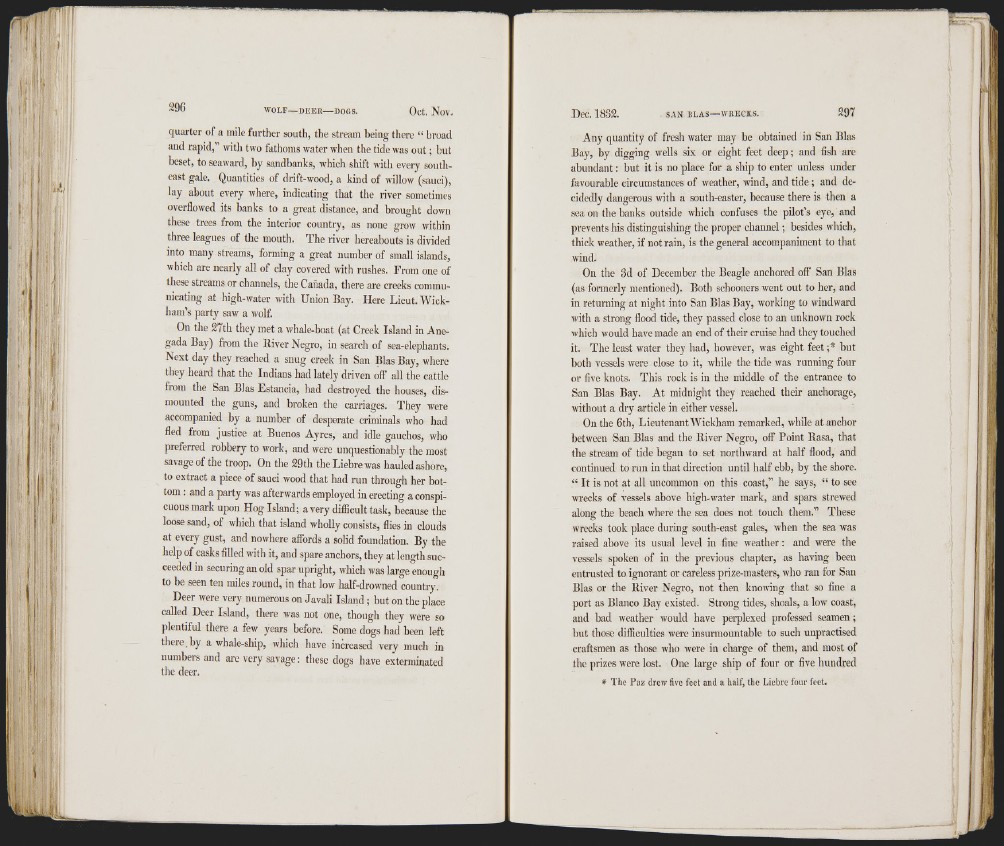
Í'í . , .1 ii
í 1
•ìli ■
,
í
'6 ,
i!
if I >1
296 WOLF— DEEH DOGS. Oct. Nov.
quarter of a mile further south, the stream heing there “ broad
and rapid,” with two fathoms water when the tide was out ; but
beset, to seaward, by sandbanks, which shift with every soutli-
east gale. Quantities of drift-wood, a kind of willow (sauci),
lay about every where, indicating that the river sometimes
overflowed its banks to a great distance, and brought down
these trees from the interior country, as none grow within
three leagues of the mouth. The river hereabouts is divided
into many streams, forming a great number of small islands,
which are nearly all of clay covered with rushes. From one of
these streams or channels, the Cañada, there are creeks communicating
at high-water with Union Bay. Here Lieut. Wickham’s
party saw a wolf.
On the 27th they met a whale-boat (at Creek Island in Anegada
Bay) from the River Negro, in search of sea-elephants.
Next day they reached a snug creek in San Bias Bay, where
they heai-d that the Indians had lately driven off all the cattle
from the San Bias Lstancia, had destroyed the houses, dismounted
the guns, and broken the carriages. They were
accompanied by a number of desperate criminals who had
fled from justice at Buenos Ayres, and idle gauchos, who
preferred robbery to work, and were unquestionably the most
savage of the troop. On the 29th the Liebre was hauled ashore,
to extract a piece of sauci wood that had run through her bottom
: and a party was afterwards employed in erecting a conspicuous
mark upon Hog Island; a very difficult task, because the
loose sand, of which that island wholly consists, flies in clouds
at every gust, and nowhere affords a solid foundation. By the
help of casks filled with it, and spare anchors, they at length succeeded
in securing an old spar upright, which was large enough
to be seen ten miles round, in that low half-drowned country”
Deer were very numerous on Javali Island ; but on the place
called Deer Island, there was not one, though they were so
plentiful there a few years before. Some dogs had been left
there, by a whale-ship, which have increased very much in
numbers and are very savage: these dogs have exterminated
the deer.
Dec. 1832. SAN BLAS WRECKS. 297
Any quantity of fresh water may be obtained in San Bias
Bay, by digging wells six or eight feet deep; and fish are
abundant: but it is no place for a ship to enter unless under
favourable circumstances of weather, wind, and tide ; and decidedly
dangerous with a south-easter, because there is then a
sea on the banks outside which confuses the pilot’s eye, and
prevents his distinguishing the proper channel; besides which,
thick weather, if not rain, is the general accompaniment to that
wind.
On the 3d of December the Beagle anchored off San Bias
(as fonnerly mentioned). Both schooners went out to her, and
in returning at night into San Bias Bay, working to windward
with a strong flood tide, they passed close to an unknown rock
which would have made an end of their cruise had they touched
it. The least water they had, however, was eight feet ;* but
both vessels were close to it, while the tide was running four
or five knots. This rock is in the middle of the entrance to
San Bias Bay. At midnight they reached their anchorage,
without a dry article in either vessel.
On the 6th, Lieutenant Wickham remarked, while at anchor
between San Bias and the River Negro, off Point Rasa, that
the stream of tide began to set northward at half flood, and
continued to run in that direction until half ebb, by the shore.
“ It is not at all uncommon on this coast,” he says, “ to see
wrecks of vessels above high-water mark, and spars strewed
along the beach where the sea does not touch them.” These
wrecks took place during south-east gales, when the sea was
raised above its usual level in fine weather ; and were the
vessels spoken of in the previous chapter, as having been
entrusted to ignorant or careless prize-masters, who ran for San
Bias or the River Negro, not then knowing that so fine a
port as Blanco Bay existed. Strong tides, shoals, a low coast,
and bad weather would have perplexed professed seamen;
hut those difficulties were insurmountable to such unpractised
craftsmen as those who were in charge of them, and most of
the prizes were lost. One large ship of four or five hundred
* The Paz drew five feet and a half, the Liebre four feet.